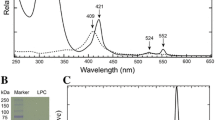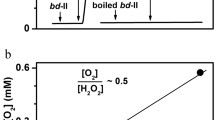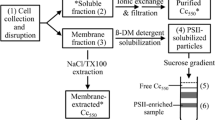Abstract
Cytochrome c553 of Heliobacterium modesticaldum is the donor to P800 +, the primary electron donor of the heliobacterial reaction center (HbRC). It is a membrane-anchored 14-kDa cytochrome that accomplishes electron transfer from the cytochrome bc complex to the HbRC. The petJ gene encoding cyt c 553 was cloned and expressed in Escherichia coli with a hexahistidine tag replacing the lipid attachment site to create a soluble donor that could be made in a preparative scale. The recombinant cytochrome had spectral characteristics typical of a c-type cytochrome, including an asymmetric α-band, and a slightly red-shifted Soret band when reduced. The EPR spectrum of the oxidized protein was characteristic of a low-spin cytochrome. The midpoint potential of the recombinant cytochrome was +217 ± 10 mV. The interaction between soluble recombinant cytochrome c 553 and the HbRC was also studied. Re-reduction of photooxidized P800 + was accelerated by addition of reduced cytochrome c 553. The kinetics were characteristic of a bimolecular reaction with a second order rate of 1.53 × 104 M−1 s−1 at room temperature. The rate manifested a steep temperature dependence, with a calculated activation energy of 91 kJ mol−1, similar to that of the native protein in Heliobacillus gestii cells. These data demonstrate that the recombinant soluble cytochrome is comparable to the native protein, and likely lacks a discrete electrostatic binding site on the HbRC.







Similar content being viewed by others
References
Albert I, Rutherford AW, Grav H, Kellermann J, Michel H (1998) The 18 kDa cytochrome c553 from Heliobacterium gestii: gene sequence and characterization of the mature protein. Biochemistry 37(25):9001–9008. doi:10.1021/bi9731347
Azai C, Tsukatani Y, Itoh S, Oh-oka H (2010) C-type cytochromes in the photosynthetic electron transfer pathways in green sulfur bacteria and heliobacteria. Photosynth Res 104(2–3):189–199. doi:10.1007/s11120-009-9521-4
Berry EA, Trumpower BL (1987) Simultaneous determination of hemes a, b, and c from pyridine hemochrome spectra. Anal Biochem 161(1):1–15
Drepper F, Mathis P (1997) Structure and function of cytochrome c2 in electron transfer complexes with the photosynthetic reaction center of Rhodobacter sphaeroides: optical linear dichroism and EPR. Biochem 36(6):1428–1440. doi:10.1021/bi961351m
Dutton PL, Petty KM, Bonner HS, Morse SD (1975) Cytochrome c2 and reaction center of Rhodospeudomonas spheroides Ga. membranes. Extinction coefficients, content, half-reduction potentials, kinetics and electric field alterations. Biochim Biophys Acta 387(3):536–556
Feissner RE, Richard-Fogal CL, Frawley ER, Loughman JA, Earley KW, Kranz RG (2006) Recombinant cytochromes c biogenesis systems I and II and analysis of haem delivery pathways in Escherichia coli. Mol Microbiol 60(3):563–577. doi:10.1111/j.1365-2958.2006.05132.x
Flores M, Isaacson R, Abresch E, Calvo R, Lubitz W, Feher G (2007) Protein-cofactor interactions in bacterial reaction centers from Rhodobacter sphaeroides R-26: II. Geometry of the hydrogen bonds to the primary quinone Q(A)(-) by H-1 and H-2 ENDOR spectroscopy. Biophys J 92(2):671–682. doi:10.1529/Biophysj.106.092460
Hauska G, Schoedl T, Remigy H, Tsiotis G (2001) The reaction center of green sulfur bacteria. Biochim Biophys Acta 1507(1–3):260–277
Heinnickel M, Golbeck JH (2007) Heliobacterial photosynthesis. Photosynth Res 92(1):35–53
Madigan MT, Ormerod JG (1995) Taxonomy, physiology and ecology of heliobacteria. In: Blankenship RE, Madigan MT, Bauer CE (eds) Anoxygenic photosynthetic bacteria. Kluwer Academic Publishers, Dordrecht, pp 17–30
Morrissey JH (1981) Silver stain for proteins in polyacrylamide gels: a modified procedure with enhanced uniform sensitivity. Anal Biochem 117(2):307–310
Nakamura A, Suzawa T, Kato Y, Watanabe T (2011) Species dependence of the redox potential of the primary electron donor p700 in photosystem I of oxygenic photosynthetic organisms revealed by spectroelectrochemistry. Plant Cell Physiol 52(5):815–823. doi:10.1093/pcp/pcr034
Nitschke W, Liebl U, Matsuura K, Kramer DM (1995) Membrane-bound c-type cytochromes in Heliobacillus mobilis. In vivo study of the hemes involved in electron donation to the photosynthetic reaction center. Biochem 34(37):11831–11839
Oh-oka H (2007) Type 1 reaction center of photosynthetic heliobacteria. Photochem Photobiol 83(1):177–186. doi:10.1562/2006-03-29-IR-860
Oh-oka H, Kamei S, Matsubara H, Iwaki M, Itoh S (1995) Two molecules of cytochrome c function as the electron donors to P840 in the reaction center complex isolated from a green sulfur bacterium, Chlorobium tepidum. FEBS Lett 365(1):30–34
Oh-oka H, Iwaki M, Itoh S (1997) Viscosity dependence of the electron transfer rate from bound cytochrome c to P840 in the photosynthetic reaction center of the green sulfur bacterium Chlorobium tepidum. Biochem 36(30):9267–9272
Oh-oka H, Iwaki M, Itoh S (1998) Membrane-bound cytochrome c z couples quinol oxidoreductase to the P840 reaction center complex in isolated membranes of the green sulfur bacterium Chlorobium tepidum. Biochem 37(35):12293–12300
Oh-Oka H, Iwaki M, Itoh S (2002a) Electron donation from membrane-bound cytochrome c to the photosynthetic reaction center in whole cells and isolated membranes of Heliobacterium gestii. Photosynth Res 71(1–2):137–147. doi:10.1023/A:1014911832504
Oh-oka H, Iwaki M, Itoh S (2002b) Electron donation from membrane-bound cytochrome c to the photosynthetic reaction center in whole cells and isolated membranes of Heliobacterium gestii. Photosyn Res 71(1–2):137–147
Okumura N, Shimada K, Matsuura K (1994) Photo-oxidation of membrane-bound and soluble cytochrome c in the green sulfur bacterium Chlorobium tepidum. Photosynth Res 41(1):125–134
Ozturk Y, Lee DW, Mandaci S, Osyczka A, Prince RC, Daldal F (2008) Soluble variants of Rhodobacter capsulatus membrane-anchored cytochrome cy are efficient photosynthetic electron carriers. J Biol Chem 283(20):13964–13972. doi:10.1074/jbc.M800090200
Prince RC, Gest H, Blankenship RE (1985) Thermodynamic properties of the photochemical reaction center of Heliobacterium chlorum. Biochimica et Biophysica Acta (BBA)—Bioenergetics 182:345–349
Redding KE, Sarrou I, Rappaport F, Santabarbara S, Lin S, Reifschneider KT (2013) Modulation of the fluorescence yield in heliobacterial cells by induction of charge recombination in the photosynthetic reaction center. Photosynth Res. doi:10.1007/s11120-013-9957-4
Sarrou I, Khan Z, Cowgill J, Lin S, Brune D, Romberger S, Golbeck JH, Redding KE (2012) Purification of the photosynthetic reaction center from Heliobacterium modesticaldum. Photosynth Res 111(3):291–302. doi:10.1007/s11120-012-9726-9
Stoll S, Schweiger A (2006) EasySpin, a comprehensive software package for spectral simulation and analysis in EPR. J Magn Reson 178(1):42–55. doi:10.1016/J.Jmr.08.013
Tamura N, Itoh S, Yamamoto Y, Nishimura M (1981) Electrostatic interaction between plastocyanin and P700 in the electron-transfer reaction of photosystem I-enriched particles. Plant Cell Physiol 22(4):603–612
Walker FA, Reis D, Balke VL (1984) Models of the cytochromes-B.5. Electron-paramagnetic-res studies of low-spin iron(III) tetraphenylporphyrins. J Am Chem Soc 106(23):6888–6898. doi:10.1021/Ja00335a003
Wang S, Li X, Williams JC, Allen JP, Mathis P (1994) Interaction between cytochrome c2 and reaction centers from purple bacteria. Biochem 33(27):8306–8312
Acknowledgments
This work was funded by the Division of Chemical Sciences, Geosciences, and Biosciences, Office of Basic Energy Sciences of the U.S. Department of Energy through grant DE-SC0010575 to KER. We thank Andrei Astashkin (Univ. of Arizona) for assistance with the EPR measurements and Patricia Baker for assistance with growing heliobacteria.
Author information
Authors and Affiliations
Corresponding author
Electronic supplementary material
Below is the link to the electronic supplementary material.
Rights and permissions
About this article
Cite this article
Kashey, T.S., Cowgill, J.B., McConnell, M.D. et al. Expression and characterization of cytochrome c 553 from Heliobacterium modesticaldum . Photosynth Res 120, 291–299 (2014). https://doi.org/10.1007/s11120-014-9982-y
Received:
Accepted:
Published:
Issue Date:
DOI: https://doi.org/10.1007/s11120-014-9982-y




